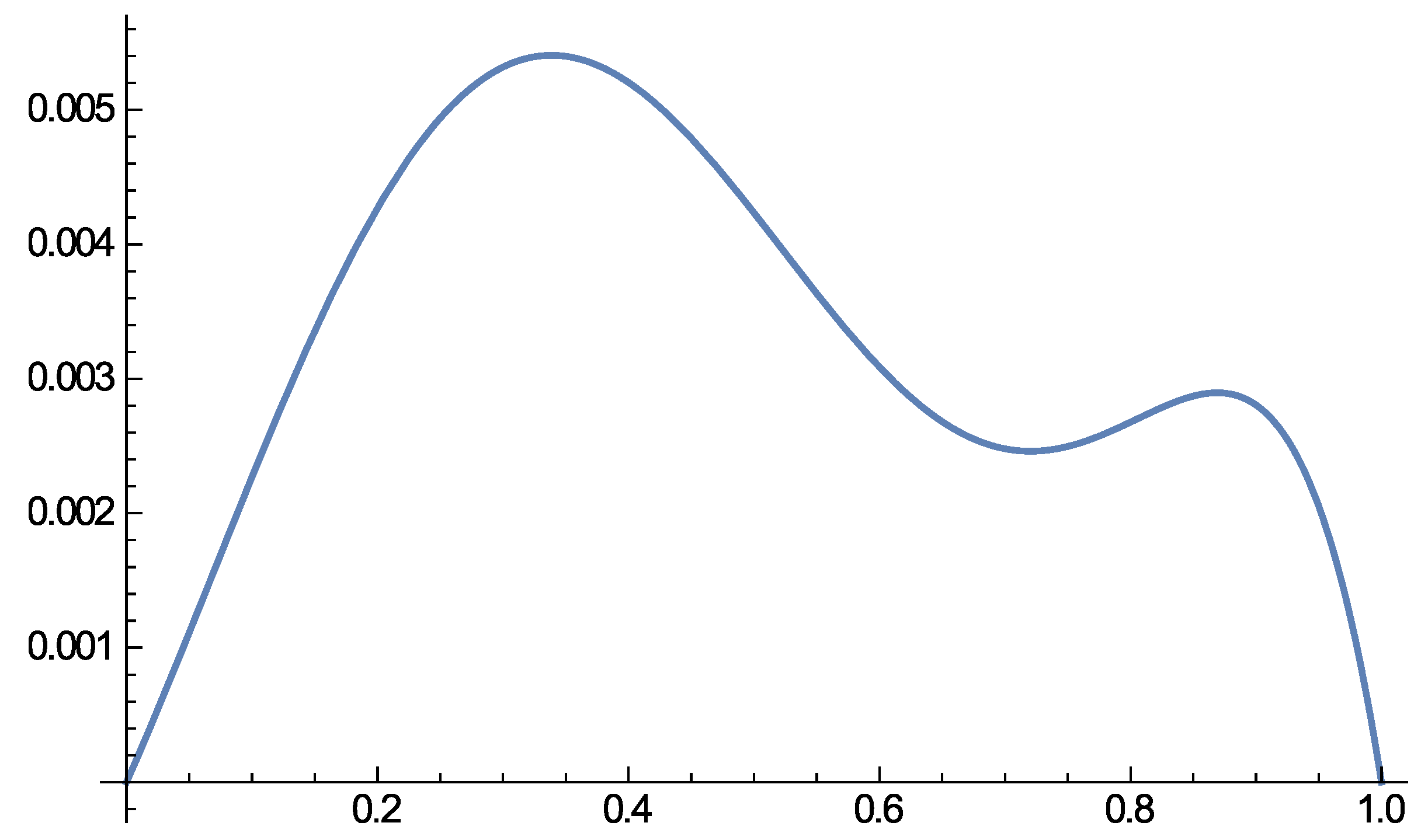Polynomial Least Squares Method for Fractional Lane–Emden Equations
Abstract
1. Introduction
2. The Polynomial Least Squares Method
- (1)
- (2)
- (3)
- We compute as values which give the minimum of the functional (9) and the value of , as functions of using the initial conditions.
- (4)
- Using the constants thus determined, we construct the polynomial:
Error Estimation
3. Applications
3.1. Application 1
3.2. Application 2
3.3. Application 3
4. Conclusions
Author Contributions
Funding
Conflicts of Interest
References
- Lane, J.H. On the Theoretical Temperature of the Sun under the Hypothesis of a Gaseous Mass Maintaining Its Volume by Its Internal Heat and Depending on the Laws of Gases Known to Terrestrial Experiment. Am. J. Sci. Arts 1870, 50, 57–70. [Google Scholar] [CrossRef]
- Emden, R. Anwendungen Der Mechanischen Warmetheorie Auf Kosmologische Und Meteorologische Probleme; B.G. Teubner: Leipzig/Berlin, Germany, 1907. [Google Scholar]
- Mechee, M.S.; Senu, N. Numerical Study of Fractional Differential Equations of Lane-Emden Type by Method of Collocation. Appl. Math. 2012, 851–856. [Google Scholar] [CrossRef]
- Syam, M.I. Analytical Solution of the Fractional Initial Emden–Fowler Equation Using the Fractional Residual Power Series Method. Int. J. Appl. Comput. Math. 2018, 4, 106. [Google Scholar] [CrossRef]
- Nasab, A.K.; Atabakan, Z.P.; Ismail, A.I.; Ibrahim, R.W. A numerical method for solving singular fractional Lane–Emden type equations. J. King Saud Univ. Sci. 2018, 30, 120–130. [Google Scholar] [CrossRef]
- Yuzbasi, S. A numerical approach for solving a class of the nonlinear Lane-Emden type equations arising in astrophysics. Math. Method Appl. Sci. 2011, 34, 2218–2230. [Google Scholar]
- Podlubny, I. Fractional Differential Equations; Academic Press: San Diego, CA, USA, 1999. [Google Scholar]
- Fazly, M.; Wei, J. On Finite Morse Index Solutions of Higher Order Fractional Lane-Emden Equations. Am. J. Math. 2017, 139, 433–460. [Google Scholar] [CrossRef]
- Davila, J.; Dupaigne, L.; Wei, J. On the fractional Lane-Emden equation. Trans. Am. Math. Soc. 2017, 369, 6087–6104. [Google Scholar] [CrossRef]
- Saeed, U. Haar Adomian Method for the Solution of Fract. Nonlinear Lane-Emden Type Equations Arising in Astrophysics. Taiwan. J. Math. 2017, 21, 1175–1192. [Google Scholar] [CrossRef]
- Atabakzadeh, M.H.; Akrami, M.H.; Erjaee, G.H. Chebyshev operational matrix method for solving multi-order fract. ordinary differential equations. Appl. Math. Model. 2013, 37, 8903–8911. [Google Scholar] [CrossRef]
- Mirza, B.M. Approximate analytical solutions of the Lane-Emden equation for a self-gravitating isothermal gas sphere. Mon. Not. R. Astron. Soc. 2009, 395, 2288–2291. [Google Scholar] [CrossRef]
- Nouh, M.I. Accelerated power series solution of polytropic and isothermal gas spheres. New Astron. 2004, 9, 467–473. [Google Scholar] [CrossRef]
- Hunter, C. Series solutions for polytropes and the isothermal sphere. Mon. Not. R. Astron. Soc. 2001, 328, 839–847. [Google Scholar] [CrossRef]
- Caruntu, B.; Bota, C. Approximate polynomial solutions of the nonlinear Lane–Emden type equations arising in astrophysics using the squared remainder minimization method. Comput. Phys. Commun. 2013, 184, 1643–1648. [Google Scholar] [CrossRef]
- Natarajan, P.; Lynden-Bell, D. An analytic approximation to the isothermal sphere. Mon. Not. R. Astron. Soc. 1997, 286, 268–270. [Google Scholar] [CrossRef]
- Bota, C.; Caruntu, B. Analytical approximate solutions for quadratic Riccati differential equation of fract. order using the Polynomial Least Squares Method. Chaos Solut. Fractals 2017, 102, 339–345. [Google Scholar] [CrossRef]

© 2019 by the authors. Licensee MDPI, Basel, Switzerland. This article is an open access article distributed under the terms and conditions of the Creative Commons Attribution (CC BY) license (http://creativecommons.org/licenses/by/4.0/).
Share and Cite
Căruntu, B.; Bota, C.; Lăpădat, M.; Paşca, M.S. Polynomial Least Squares Method for Fractional Lane–Emden Equations. Symmetry 2019, 11, 479. https://doi.org/10.3390/sym11040479
Căruntu B, Bota C, Lăpădat M, Paşca MS. Polynomial Least Squares Method for Fractional Lane–Emden Equations. Symmetry. 2019; 11(4):479. https://doi.org/10.3390/sym11040479
Chicago/Turabian StyleCăruntu, Bogdan, Constantin Bota, Marioara Lăpădat, and Mădălina Sofia Paşca. 2019. "Polynomial Least Squares Method for Fractional Lane–Emden Equations" Symmetry 11, no. 4: 479. https://doi.org/10.3390/sym11040479
APA StyleCăruntu, B., Bota, C., Lăpădat, M., & Paşca, M. S. (2019). Polynomial Least Squares Method for Fractional Lane–Emden Equations. Symmetry, 11(4), 479. https://doi.org/10.3390/sym11040479





